Overview
PRINTING United Expo 2023 just wrapped up in Atlanta, and from all sides it seems like it was a great success. The convergence model it is structured around is designed to allow print service providers an opportunity to see and consider new product expansion and convergence opportunities and that seems to work. At the event, there were two big halls, each of which was focused on different print equipment, services, and support. Hall B booths were primarily centered around commercial print, a smattering of packaging, and some large-format graphics. Hall C contained booths providing large-format graphics equipment as well as textile, direct to garment, direct to shape, software, and a lot of other interesting booths.
 The show was well attended with registration rates similar or just a bit above last year (we are still waiting on the final numbers). I spoke with many exhibitors on the floor and found that they were very happy with the show and the quality of the attendees. Likewise, I spoke with many attendees who found their event visit very positive. Not just for the equipment, but also the educational content. If there were any negatives, it really centered around the size of the exhibit floor and the amount of “steps” people were putting in each day. In all fairness, there is no way to present an event with this scope in a smaller venue, and from my understanding, next year’s event in Las Vegas will be even bigger, so get better shoes!
The show was well attended with registration rates similar or just a bit above last year (we are still waiting on the final numbers). I spoke with many exhibitors on the floor and found that they were very happy with the show and the quality of the attendees. Likewise, I spoke with many attendees who found their event visit very positive. Not just for the equipment, but also the educational content. If there were any negatives, it really centered around the size of the exhibit floor and the amount of “steps” people were putting in each day. In all fairness, there is no way to present an event with this scope in a smaller venue, and from my understanding, next year’s event in Las Vegas will be even bigger, so get better shoes!
Print and Packaging Highlights
There were lots of product introductions and reintroductions at PRINTING United 2023. While I can’t cover them all, I will attempt to identify some of the ones I found most interesting, primarily on the commercial print and packaging side. For those I missed, and there are a lot, we will have to get to you another time!
Fujifilm had the biggest booth, and for good reason. This was their “coming to North America party.” While the Fujifilm Graphic Communications Division has had a presence in North America for decades, it has been primarily in offset and flexo plates, inks, chemistry, wide-format printers, and support. Although they did introduce the first J Press cut-sheet production inkjet press as part of the global launch in 2016 in North America as well. This year, as a result of the dissolution of the 58-year-old Fuji Xerox joint venture, Fujifilm is now free to enter the North American market with their entire line of toner and inkjet presses, and they did!
First, they announced their fourth-generation J Press, the 750HS sheetfed digital inkjet printer with speeds of 3,600 or 5,400 sph. While not on the floor, they did show samples from their J Press FP790 aqueous flexible packaging press. Next they introduced the new branding of ApeosTM Series for their enterprise and entry-level toner printers, and Revoria PressTM for their production toner presses. Some of these have already been in the market under Xerox branding, so specs may seem similar.
Notably, they introduced a unique cut sheet B2 toner press the Revoria PressTM GC12500. This was quite a surprise since the inherent wisdom was that you couldn’t make a toner press with a print width beyond 13 in. This four-color press has a print speed of up to 2500 B2 sph at a resolution of 2,400 X 2,400 dpi. It supports a media range of 64–450 gsm stock with a maximum sheet size of 26 x 29.5 in.
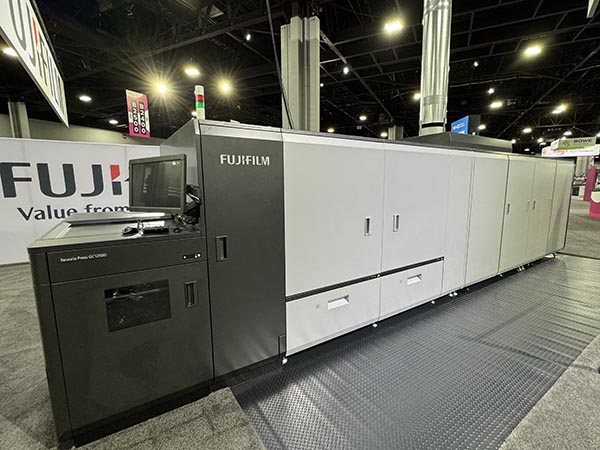
Revoria PressTM GC12500
They also showed their Revoria Press PC1120, which is the same six-color engine used in the Xerox Iridesse and the Sharp BP-1200S Color Press. Xerox has signed an agreement with Fujifilm to continue selling some of their products under the Xerox brand, providing a continuation of their available printer line. Undoubtedly, we will see some more companies licensing Fujifilm hardware, like Xerox, Sharp, etc.

Revoria Press PC1120
This isn’t surprising since there are many press manufacturers licensing press hardware from other manufacturers. Heidelberg licenses their toner press from Ricoh, Ricoh licenses their cut-sheet inkjet press from Kyocera, some wide-format from EFI, and on and on. Of course, each OEM implementation brings its own value-add to the presses.
While Xerox may not be going to drupa, they did have an impressive booth with their Iridesse (see above) production press and their Baltoro HF Inkjet Press. With the recent changes to their corporate structure, we have been told to expect them to get back to developing and marketing new press hardware in the near future.
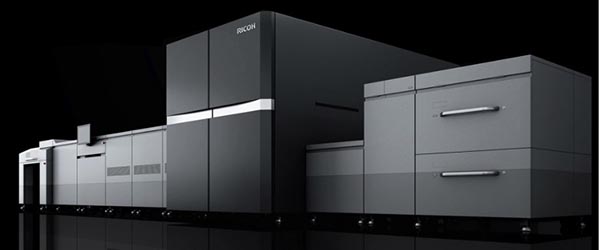
Ricoh Pro Z75
Speaking of Ricoh, they “officially” launched their Ricoh Pro Z75, a 4,500 sph duplexing B2 cut-sheet production inkjet press. They also announced their updated Ricoh TotalFlow® Producer software. Ricoh has taken an interesting approach with this vendor agnostic cloud based solution. This scalable solution can manage print workflows from onboarding through prepress, print and finishing.
Sharp is expanding from enterprise and in-plant to full production with the introduction of the previously mentioned BP-1200S. They are now working with their distribution channel to bring them up to speed to market, sell and support the new requirements.
SCREEN officially launched the Trupress PAC 830F. While not on the floor it is an 830 mm wide, 75 mpm aqueous based flexible packaging press, and announced their first installation at Chiyoda Gravure Corporation in Tokyo, Japan. SCREEN also showed their TruePress L350UV SAI, Screen and their Screen Pac 520P a paper based flexible packaging press.

Canon iX1700
Canon showed their growing V Series of toner presses and highlighted the upcoming iX1700 B3 duplex cut-sheet inkjet press and the LX2000 inkjet label press. They also focused on their wide-format offerings including their Colorado-M series, the Arizona 2300 series, and the imagePROGRAF. They displayed the innovative solutions from signage to textiles that were possible on these devices.
Durst, which would normally show their expansive wide-format printer line at this event, was also showing their Tau RSC label printer platform. This 1200-dpi production inkjet press is not just for labels, and can easily do flexible packaging print. The available UV inks can support a wide range of label and flexible packaging substrates. They also showed their innovative HAWK EYE, an intelligent closed-loop system for nozzle compensation.
Heidelberg didn’t have any offset presses on the floor this year, although they did have a customer event at their US headquarters the day before PRINTING United. Instead, they displayed the new upgradable Gallus One inkjet label/flexible packaging press.
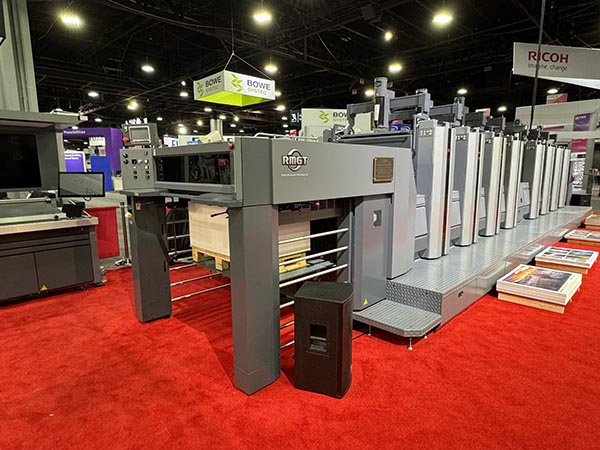
RMGT 970PF
RMGT presented the North American debut of the RGMT 970PF 8-Up+ Color Perfecting Press in their 50-ft.-long booth. The 4/4 perfecting press supports a 25 x 38-in. format sheet and prints up to 15,000 sph. The press on display was configured with RGMT LED UV curing technology that Ryobi effectively invented for sheetfed presses and introduced at drupa 2008, along with Toyo inks and Panasonic lamps. Additionally, it had the RGMT ASAP system (Automatic Smart Assist Printing). In essence, this means that the press will run autonomously from job to job to job without any press operator intervention.
HP showed their line of wide-format presses, and had an offsite event at their Graphic Experience Center the day before as well for people who wanted to see their production print line of equipment.
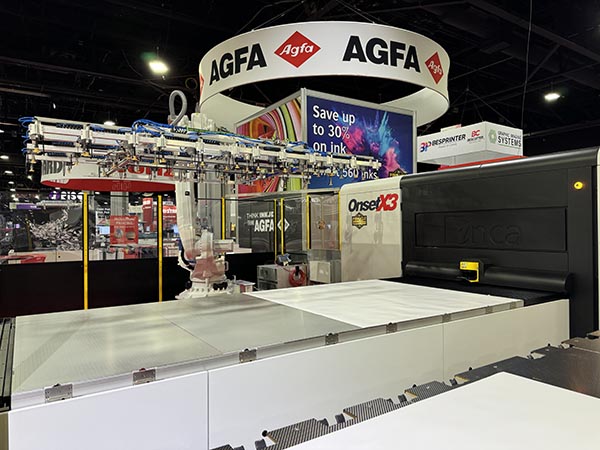
Agfa Onset X
Agfa had their upgradable Onset X printer on display. This is one of the only true high-productivity flatbed wide-format printers available in the market. It can print more than 15,000 square feet an hour and is designed to run continuous 24/7 production configured with “Hal,” their automation robot. The eight-channel Onset X1 is configured for CMYK plus LcLmWO. However, as your production volume needs increase it can be upgraded with an additional six-channel carriage to become the Onset X2 (adding a second set of CMYK) then transformed again into a top-of-the-line Onset X3 (3 x CMYK plus W or O).
Enfocus introduced their new Enfocus Review, a cloud-based workflow that provides fast and accurate PDF viewing in the browser. This includes overprint, and color spaces that often lead to inaccurately rendered PDF. It has seamless Switch and Pitstop integration and will work with the newly launched Enfocus Cloud. Like many other workflow software developers, they are moving everything to the cloud, one step at a time.
Finishing
It wasn’t all about presses, there was a lot of new finishing equipment there as well. As PSPs look for ways to extend their product offerings, folding cartons are a natural extension. In line with that, KAMA showed their ProCut 76 Foil Packaging for embellishment, die cutting, stripping, and blanking and the fully automatic FlexFold 52i folder gluer.
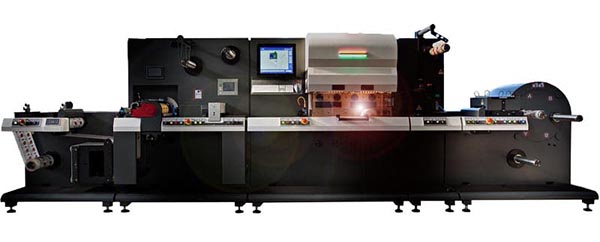
SEI LabelMaster
Matik SEI Laser showed their LabelMaster, the fastest continuous-feed CO2 laser system on the market. It can perform laser-based processes including cutting, scoring, marking, micro-perforating, versioning, and other types of personalization, all inline in a single pass. They also showed the 63-in. Mercury Wide-Format Laser Cutting and Marking system cutting acrylic, although it’s a very flexible platform that can cut PMMA, acetates, ABS, plastics, micanite, wood, leather, paper, cardboard, and textiles. It operates at 2 Gs of acceleration, one of the fastest plotters available—yet isn’t as fast as their X-Wave platform, the fastest plotter in the world, which operates at 10 Gs of acceleration. This makes it four to five times faster than a traditional zone style plotter.
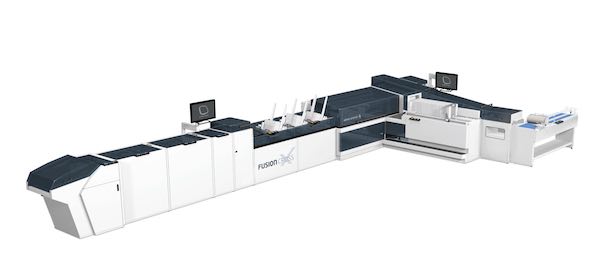
Bowe Systec Fusion Speed
Bowe Systec debuted their flagship Fusion Speed BOXIT Mail Tray Automation system. This is the fastest of their Fusion series and processes up to 30,000 letters an hour. The automatic traying system is fully automated from rolled paper in the front of the system, and stacked and loaded #10 or 6 x 9-in. envelopes in the hoppers with sorted and filled trays coming out of the back of the line. The speed makes it almost impossible for an operator to keep up with so that’s where the BOXIT automation comes in. One postal tray can be filled every 30 to 40 seconds.
In Conclusion
Many people ask if the big trade show has outlived its usefulness. From where I sit, the answer is a resounding NO. In addition to the equipment, these events are a hub for community networking and preserving the industry legacy. Granted, some events may not offer enough or enough differentiation, but generally when you ask the exhibitors and the attendees, they see the value. There will probably continue to have to be some realignment of some of the existing events, but that is a good thing. Doing the same thing over and over isn’t necessarily healthy or beneficial. Looking forward to next year’s PRINTING United Expo in Las Vegas, September 10–12, 2024.
More to Come…
2023 is moving at an increased pace, with drupa 2024 beginning to shine its light. I would like to address your interests and concerns in future articles as it relates to the manufacturing of Print, Packaging, and Labels, and how, if at all, it drives future workflows including “Industry 4.0.” If you have any interesting examples of hybrid and bespoke manufacturing, I am very anxious to hear about them. Please feel free to contact me at [email protected] with any questions, suggestions or examples of interesting applications.















Discussion
Only verified members can comment.